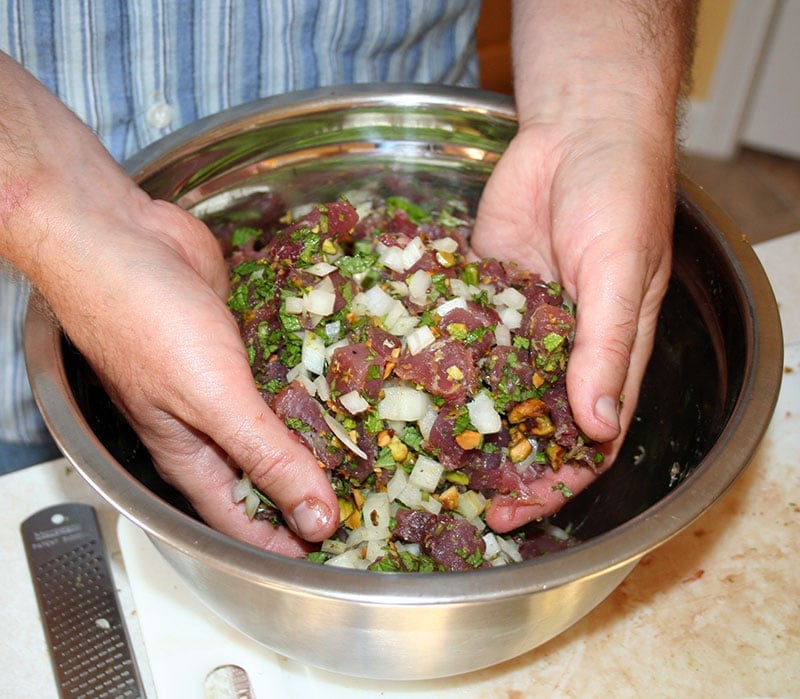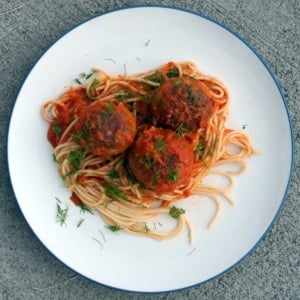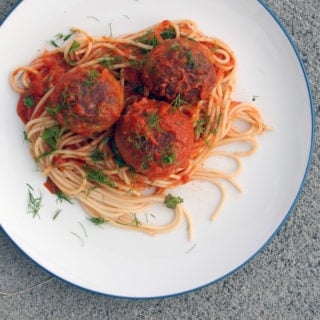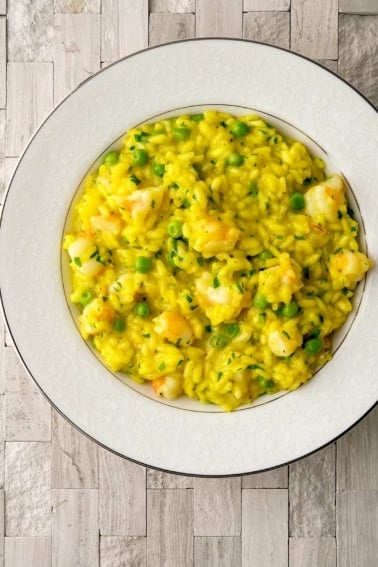As an Amazon Associate I earn from qualifying purchases.
Most cultures that fish for tuna make tuna meatballs, but I find the Sicilians do it the best.
I developed this tuna meatball recipe a decade ago, after a great tuna trip in North Carolina.

This trip was epic, one of the few that punch through the fog of 45 years’ worth of fishing trips. It was aboard the Stormy Petrel II, 40 miles out of Oregon Inlet on a warm Saturday morning in September, right after a hurricane.
My friends Jamie and Brian had invited me on their annual offshore fishing trip, Killboxapalooza. Uh, wha? Killboxapalooza is what they call their big fishing trip, the one where they do their best to catch as many fish as they can to freeze for winter.
Normally, tuna fishing is a matter of trolling baits and waiting. You sit back, drink a beer and wait for a tuna to hit a line. Then someone gets up and fights the fish, hopefully bringing it to the boat. Everyone takes a turn at the reel as you get more and more hookups. If you’re lucky, everyone gets a tuna. But this was not a normal day. The first tuna hit before the mate had even finished setting the lines. Fish on!
In the end, I’d caught three yellowfin and three bonito, and the 10 of us on the boat had caught 32 yellowfin and 12 bonito. Each of us brought home so much tuna that it could feed us for months. I think my bag weighed close to 30 pounds of pure meat. I gave a bunch of it to my friend Mike, who was putting me up in North Carolina. It was cool to be able to cook some tuna for Mike. We’ve been friends for a powerful long time and I jumped at the chance to make something for him to say thanks.
The loins got saved for other recipes, like another Sicilian tuna dish I make, grilled tuna with a Sicilian salad. I also dearly love tuna crudo, and tuna poke is an easy weeknight option.
All the trim I cut up for these tuna meatballs. They have lots of mint, pistachio nuts, breadcrumbs and a little bit of hot pepper. I cooked the meatballs in my fennel-tomato sauce, which I use a lot with seafood.

I am happy to say the dish was a winner. Unless you ate a meatball with no sauce and concentrated on the flavor, you couldn’t tell that these were tuna meatballs. It was bizarre. I totally expected to get a fishy flavor, which was fine, as these things were primarily ground tuna, but there wasn’t one. All you got was meatiness, a hit of mint and occasionally a burst of pistachio flavor.
Once made, you can cook and then freeze your tuna meatballs. Reheat them in whatever sauce you want to eat them with, right out of the freezer and slowly on the stove.
Sicilian Tuna Meatballs
Ingredients
- 1 1/2 pounds tuna
- 2/3 cup breadcrumbs
- 1/3 cup shelled pistachios or almonds, chopped
- 1 cup minced onion
- 1/2 cup chopped fresh mint
- Zest of a lemon
- 1 tablespoon salt
- 1 egg
- Flour for dusting
- Olive oil for frying
- 1 recipe, fennel-tomato sauce
Instructions
- Chop the tuna into 1/2 inch pieces. Put the tuna, mint, pistachios and the chopped onion in a food processor and pulse to combine. You want a rough mixture, not a smooth paste. Put the tuna mixture into a large bowl with the breadcrumbs, salt, lemon zest and egg and mix well with your clean hands for a minute or so. You want everything combined well and you want the proteins in the egg and tuna to bind the mixture.
- Using an ice cream scoop or large spoon to scoop out the meat, roll into meatballs. You should be able to make about 20 golf ball-sized meatballs. Roll each meatball in flour and fry in enough olive oil to come half way up the sides of a large frying pan. You will probably need about 1/2 cup. Fry gently until browned over medium heat, about 15 to 20 minutes, and set each finished meatball on paper towels to drain.
- To finish, stew the meatballs in the tomato sauce (you can use any tomato sauce you want, if you'd rather not make the tomato-fennel sauce ) until heated through, about 5 to 10 minutes, and serve alone or with pasta.
Notes
Nutrition
Nutrition information is automatically calculated, so should only be used as an approximation.






I’m going to make this recipe on Sunday and am wondering, are the bread crumbs fresh or dried? Thank you.
Linda: Dried.
Against everyone’s advice, I froze Bonito. I had too much to eat fresh and I have a rule that I eat what I bring home. Upon thawing the fish it looked and smelled unappetizing at best. However, we made this along with your fennel spaghetti sauce and it turned out great! It wasn’t fishy at all and had a good texture and flavor. Additionally, I hate licorice & Ouzo and had never cooked with fennel, but I tried it anyway and I was surprised at how much I liked the sauce. I now wish I had more bonito in the freezer! For those who are curious, the fish were fileted immediately upon catching, and vacuum sealed and frozen the day they were caught. They were in the freezer for 2 years.
Determined not to waste anything I wanted to try this with the rest a bonito we caught after searing the top loin the night before. Wow so glad I did! I used almonds and in place of the mint which I didn’t have I used a mix of parsley, dill, cilantro and, oregano. It was fabulous, I’ll take a bonito any chance I get just for this recipe. Thanks again Hank!
I made these tonight with bonita. I don’t know if I rolled them in too much flour, or fried them at too high a temperature, but they came out more like fish falafels or fish fritters than fish meatballs. No matter, they were freakin’ delicious. Would make a great appetizer with some spicy mayonnaise. Give it a try!
I took my first tuna trip this summer, off the coast of Washington, and it was a blast! If you want to see tuna jumping into the boat, make a trip out here. We took a 2 day trip (sleep on boat, wake up on tuna grounds, fish all day, sleep on boat, wake up and head home) and the 10 of us landed almost 160 fish in 10 hours. It was so much fun, a lot of work, and I can’t wait to go again next year.
Thanks for this recipe! I have about 80lbs of tuna left after giving some to friends and look forward to trying this out!
Hey Hank – So great to read about your fishing story and these tuna meatballs are delicious. Someone just caught a bunch of tuna and gave me some right after you posted this, so it was perfect timing. You can check out my version over at https://saltpepperskillet.com/recipes/sicilian-tuna-meatballs/
Cheers,
Justin
I am an artisanal butcher and fish monger at a specialty meat store. I make this recipe every week when we get in a tuna loin and I take home the scraps we would normally throw away. A great recipe and a direction I would like to see modern cuisine take- utilizing scraps and “waste” that would normally be tossed out. True skill in the kitchen often involves making something from nothing. Excellent recipe inspired by excellent values.